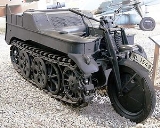
SdKfz 2
Encyclopedia
| Length: Width: Height: |
3000 mm (118") 1000 mm (39") 1200 mm (47") |
| Engine: | Watercooled four cylinder in-line engine with (OHV Overhead valve An overhead valve engine, also informally called pushrod engine or I-head engine, is a type of piston engine that places the camshaft within the cylinder block , and uses pushrods or rods to actuate rocker arms above the cylinder... ), Manufacturer: Opel Opel Adam Opel AG, generally shortened to Opel, is a German automobile company founded by Adam Opel in 1862. Opel has been building automobiles since 1899, and became an Aktiengesellschaft in 1929... (GM) |
| Capacity: Bore x Stroke: |
1478 cm³ (taxed) 1488 cm³ (real) 80 mm x 74 mm |
| Compression ratio: | 6:1 |
| Power: | 36 bhp (26 kW) |
| at: | 3400 rpm |
| Top Speed: | 70 km/h (44 mph) |
| Perm. total weight: | 1560 kg (3444 lb) |
| Gearbox: | For. 3 / Rev. 1 speed x 2 range |
| Clutch: | Single plate dry clutch |
| Carburettor: | SOLEX Off-road carburettor type 32 FJ-II |
| Crew: | 3 (Driver + 2 passengers) |
| Tire size: | 3.50-19 |
The SdKfz 2, better known as the Kleines Kettenkraftrad HK 101 or Kettenkrad for short (Ketten = tracks, krad = military abbreviation of the German
German language
German is a West Germanic language, related to and classified alongside English and Dutch. With an estimated 90 – 98 million native speakers, German is one of the world's major languages and is the most widely-spoken first language in the European Union....
word Kraftrad, the administrative German term for motorcycle), started its life as a light tractor for airborne troops. The vehicle was designed to be delivered by Junkers Ju 52 aircraft, though not by parachute. The vehicle had the advantage of being the only gun tractor small enough to fit inside the hold of the Ju 52.
Steering the Kettenkrad was accomplished by turning the handlebars: if little movement was used then the wheel would steer the vehicle, however if they were turned further they would engage the track brakes to help make turns sharper.
The SdKfz 2 was designed and built by the NSU Werke AG
NSU Motorenwerke AG
NSU Motorenwerke AG, normally just NSU, was a German manufacturer of automobiles, motorcycles and pedal cycles, founded in 1873. It was acquired by Volkswagen Group in 1969...
at Neckarsulm
Neckarsulm
Neckarsulm is a city in northern Baden-Württemberg, Germany, near Stuttgart, and part of the district Heilbronn. As of 2004, Neckarsulm had 27,296 inhabitants....
, Germany. First designed and patented in June 1939, it was first used in the invasion of the Soviet Union
Operation Barbarossa
Operation Barbarossa was the code name for Germany's invasion of the Soviet Union during World War II that began on 22 June 1941. Over 4.5 million troops of the Axis powers invaded the USSR along a front., the largest invasion in the history of warfare...
in 1941. Later in the war Stoewer
Stoewer
Stoewer was a German automobile manufacturer before World War II whose headquarters were in Stettin .The first company was founded by the Stoewer brothers, Emil and Bernhard in 1896 for manufacturing sewing machines in Stettin...
from Stettin also produced Kettenkrads under license, accounting for about 10% of the total production.
Most Kettenkrads saw service on the Eastern Front
Eastern Front (World War II)
The Eastern Front of World War II was a theatre of World War II between the European Axis powers and co-belligerent Finland against the Soviet Union, Poland, and some other Allies which encompassed Northern, Southern and Eastern Europe from 22 June 1941 to 9 May 1945...
, where they were used to lay communication cables, pull heavy loads and carry soldiers through the deep Russian mud. Later in the war, Kettenkrads were used as runway tugs for aircraft, especially for the Me 262
Messerschmitt Me 262
The Messerschmitt Me 262 Schwalbe was the world's first operational jet-powered fighter aircraft. Design work started before World War II began, but engine problems prevented the aircraft from attaining operational status with the Luftwaffe until mid-1944...
jet fighters. In order to save aviation fuel, the aircraft would be towed to the runway, rather than taxiing under their own power.
The vehicle was also used in the North African theater
North African campaign
During the Second World War, the North African Campaign took place in North Africa from 10 June 1940 to 13 May 1943. It included campaigns fought in the Libyan and Egyptian deserts and in Morocco and Algeria and Tunisia .The campaign was fought between the Allies and Axis powers, many of whom had...
and on the Western Front
Western Front (World War II)
The Western Front of the European Theatre of World War II encompassed, Denmark, Norway, Luxembourg, Belgium, the Netherlands, France, and West Germany. The Western Front was marked by two phases of large-scale ground combat operations...
.
The Kettenkrad came with a special trailer (Sd.Anh.1) that could be attached to it to improve its cargo capacity.
Being a tracked vehicle the Kettenkrad could climb up to 24° in sand and even more in hard ground, as long as the driver had courage for it.
Only two significant sub-variations of the Kettenkrad were constructed, and production of the vehicle was stopped in 1944, at which time 8,345 had been constructed. After the war the production at NSU went on until 1949 for agricultural use. Around 550 Kettenkrads were built postwar until 1948 (Some sources say 1949).

